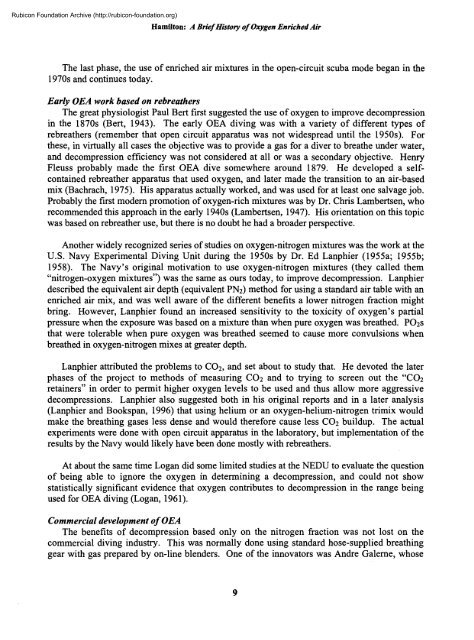Nitrox workshop dings - Divers Alert Network
Nitrox workshop dings - Divers Alert Network
Nitrox workshop dings - Divers Alert Network
You also want an ePaper? Increase the reach of your titles
YUMPU automatically turns print PDFs into web optimized ePapers that Google loves.
Rubicon Foundation Archive (http://rubicon-foundation.org)Hamilton: A Brief History of Oxygen Enriched AirThe last phase, the use of enriched air mixtures in the open-circuit scuba mode began in the1970s and continues today.Early OEA work based on rebreathersThe great physiologist Paul Bert first suggested the use of oxygen to improve decompressionin the 1870s (Bert, 1943). The early OEA diving was with a variety of different types ofrebreathers (remember that open circuit apparatus was not widespread until the 1950s). Forthese, in virtually all cases the objective was to provide a gas for a diver to breathe under water,and decompression efficiency was not considered at all or was a secondary objective. HenryFleuss probably made the first OEA dive somewhere around 1879. He developed a selfcontainedrebreather apparatus that used oxygen, and later made the transition to an air-basedmix (Bachrach, 1975). His apparatus actually worked, and was used for at least one salvage job.Probably the first modern promotion of oxygen-rich mixtures was by Dr. Chris Lambertsen, whorecommended this approach in the early 1940s (Lambertsen, 1947). His orientation on this topicwas based on rebreather use, but there is no doubt he had a broader perspective.Another widely recognized series of studies on oxygen-nitrogen mixtures was the work at theU.S. Navy Experimental Diving Unit during the 1950s by Dr. Ed Lanphier (1955a; 1955b;1958). The Navy's original motivation to use oxygen-nitrogen mixtures (they called them"nitrogen-oxygen mixtures") was the same as ours today, to improve decompression. Lanphierdescribed the equivalent air depth (equivalent PN2) method for using a standard air table with anenriched air mix, and was well aware of the different benefits a lower nitrogen fraction mightbring. However, Lanphier found an increased sensitivity to the toxicity of oxygen's partialpressure when the exposure was based on a mixture than when pure oxygen was breathed. PO2Sthat were tolerable when pure oxygen was breathed seemed to cause more convulsions whenbreathed in oxygen-nitrogen mixes at greater depth.Lanphier attributed the problems to CO2, and set about to study that. He devoted the laterphases of the project to methods of measuring CO2 and to trying to screen out the "CO2retainers" in order to permit higher oxygen levels to be used and thus allow more aggressivedecompressions. Lanphier also suggested both in his original reports and in a later analysis(Lanphier and Bookspan, 1996) that using helium or an oxygen-helium-nitrogen trimix wouldmake the breathing gases less dense and would therefore cause less CO2 buildup. The actualexperiments were done with open circuit apparatus in the laboratory, but implementation of theresults by the Navy would likely have been done mostly with rebreathers.At about the same time Logan did some limited studies at the NEDU to evaluate the questionof being able to ignore the oxygen in determining a decompression, and could not showstatistically significant evidence that oxygen contributes to decompression in the range beingused for OEA diving (Logan, 1961).Commercial development of OEAThe benefits of decompression based only on the nitrogen fraction was not lost on thecommercial diving industry. This was normally done using standard hose-supplied breathinggear with gas prepared by on-line blenders. One of the innovators was Andre Galerne, whose
















